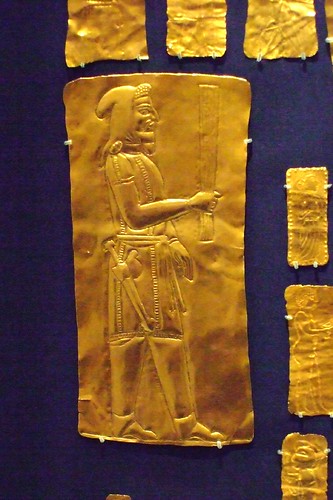
Marvelous discoveries of ancient Thracian treasures continue in Bulgaria. I truly hope I can see some of these finds some day. Apparently these antiquities were uncovered close to the site where a completely intact bronze-embellished Thracian chariot was found in September 2007.
While looking for an image of the finds I stumbled across this marvelous blog about ancient Bulgaria that provided a number of images of the chariot excavation including this one.
"In October and November 2009, archaeologist Veselin Ignatov’s team found a burial tomb of dated back to the end of 1st century and beginning of 2nd century AD, located outside of the village of Karanovo, in southern Bulgaria.
The finds at the lavish Thracian tomb include gold rings, silver cups and vessels coated with gold and clay vessels. Those include two silver cups with images of love god Eros, and a number of other ornate silver and bronze vessels." - More: Sofia News Agency
The precious items once belonged to an aristocrat descended from the ruling elite of the Odrysian Kingdom (5th -3rd century BCE). 
According to the Greek historians Herodotus and Thucydides, a royal dynasty emerged from among the Odrysian tribe in Thrace around the end of the 5th century BCE, which came to dominate much of the area and peoples between the Danube and the Aegean for the next century. Later writers, royal coin issues, and inscriptions indicate the survival of this dynasty into the early first century CE, although its overt political influence declined progressively first under Persian, Macedonian, later Roman, encroachment. Despite their demise, the period of Odrysian rule was of decisive importance for the future character of south-eastern Europe, under the Roman Empire and beyond. - Wikipedia[Image - Golden mask of 4th century BCE Thracian King discovered near Topolchene in 2007. Courtesy of News.bg]
The Odrysians built roads to develop trade and built a powerful army, at one point numbering over 150,000 men.
Under the Odrysians Greek became the language of administrators and of nobility and the Greek Alphabet was adopted; Greek customs and fashions contributed to the recasting of east Balkan society.The nobility adopted Greek fashions in dress, ornament and military equipment, spreading it to the other tribes.
In the 4th century BC, the kingdom split itself in three smaller kingdoms, of which one, with the capital at Seuthopolis survived the longest. During the Hellenistic era it was subject at various times to Alexander the Great, Lysimachus, Ptolemy II, and Philip V, and was at one time overrun by the Celts, but usually maintained its own kings. During the Roman era its Sapaean rulers were clients of Rome until Thrace was annexed as a Roman province in 46 AD. - Wikipedia
